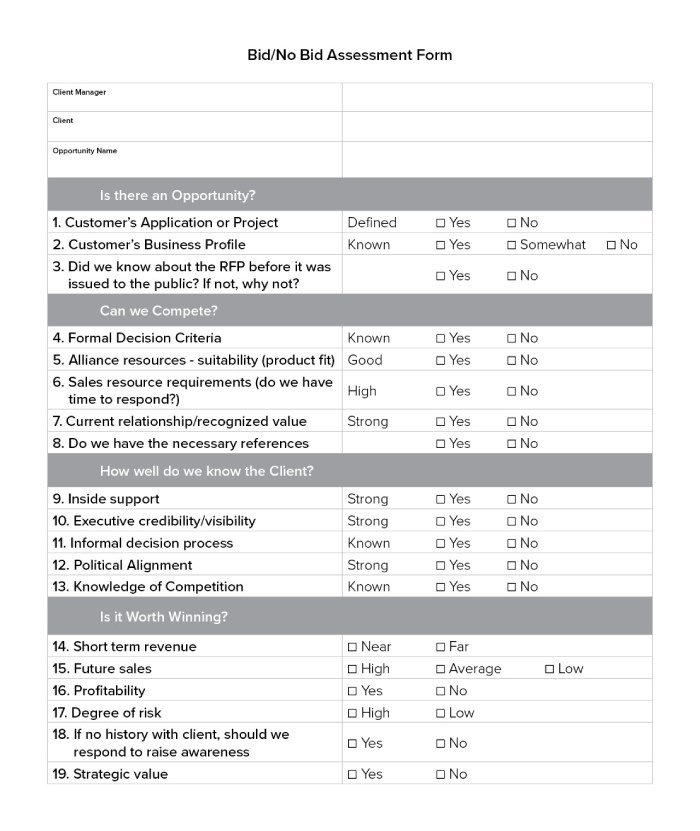Proposal Decision Process – To Bid or Not to Bid

Winning proposals are an essential part of business development, and following an effective proposal decision process is an important first step to improving your win rate. Proposals help elevate a company’s profile and win business, directly impacting the bottom line. Conversely, proposals that fail are costly. Thus, the importance of carefully determining which opportunities to pursue can not be underestimated.
Given that many firms may spend, on average, between $10,000 and $25,000 preparing a proposal, the cost of losing is high. Thus, following a rigorous bid/no bid proposal decision process is highly recommended before initiating any proposal effort. This process ensures a critical assessment of the opportunity is conducted and helps determine whether it is worth pursuing from a cost, resource and winnability perspective.
Here is a great example of an effective bid/no bid proposal decision framework.

This post discusses how you and your organization should assess opportunities and how establishing a more formal proposal decision process can increase your win rate and reduce proposal-related costs.
Self Evaluation
Developing an effective bid/no bid process requires critically analyzing your previous proposal efforts. Ask yourself:
- Are you being shortlisted > 35% – 45% of your pursuits?
If you are not shortlisted more than 30% of the time, your opportunity assessment must be reviewed and revised to improve your win rate. Either you are not being selective enough in your pursuits, or your proposals aren’t conveying your value proposition effectively. - Do you know why you’ve won and lost in the past?
Understanding why you’ve lost and won opportunities provides critical insights that can inform future proposal decisions and efforts. Every company should collect and store this information for reference. If you do not have a CRM system designed to store this kind of information, a simple spreadsheet can effectively track what you’ve learned from proposal debriefs. - Is your value proposition any different today?
The competitive landscape shifts regularly, impacting your value proposition, especially vis-a-vis your competitors. Be sure to revisit and revise your value proposition so it remains a differentiator/competitive advantage. In addition, once you analyze the reasons for wins and losses, a pattern may emerge that may indicate the need to revise your value proposition.
After completing this analysis on your company’s proposal efforts, you can begin devising a bid/no bid process to improve your win rate.
To Bid or Not to Bid Guide
Below, we provide several questions you must answer objectively to help guide your bid/no bid decision. They form an essential checklist that should shape every bid/no bid process:
Is the opportunity for you?
Did you know about this RFP? Were you expecting it? If you had no prior knowledge of the project or no existing relationship with the issuer, you would unlikely succeed in a bid. You should reconsider spending time and money on such an opportunity.
If, however, you had anticipated this, then move through the proposal decision process and carefully consider the following:
Can you compete?
If you did have knowledge of the opportunity and have an understanding of the project, then you must determine whether you can compete. Ideally, you would have a good understanding of the project based on your existing relationship with the client and will be able to determine whether your company’s solution is competitive.
Also, be aware of the timeline. Can your company spare the time and resources to pull together a competitive bid on time, and do you have a project team ready and able to deliver the project should you win? If not, do not move forward. Alternatively, you could seek outside support from companies like The Proposal Lab, specializing in proposal development.
Be sure to consider other important criteria that could work in your favour, like relevant client references, project experience, national presence, sustainability commitments, Indigenous partnerships etc.
How well do you know the client?
Consider the following when assessing your knowledge of the issuer or prospective client:
- Do you have an understanding of the formal decision criteria? If RFP doesn’t define the criteria, can you find out directly through procurement or an inside contact? Knowing this will help you better assess your company’s chances and help determine whether bidding is worthwhile.
- Do you have inside support? An existing client relationship will significantly improve your chances if your company’s value is recognized. Client contacts can potentially champion your capabilities to the internal decision-makers.
- Do you have organizational strengths that this particular client values and have relevance for this project?
- Can you demonstrate a deep understanding of the client and their project?
- Is there an informal decision process that can influence the outcome? Who or which corporate division influences the selection (e.g., procurement, finance, IT)?
- Do you know who your competitors are, and are they likely to bid on this opportunity?
If you can answer these questions effectively, you can better compete.
Is it worth winning?
When trying to secure business through a procurement process, it is vital to critically assess the value of bidding and potentially winning, given the time and money it takes to prepare a response. Your team should consider the following questions:
- Should you win, can you execute the project profitably?
- What is the degree of risk involved?
- Is there strategic value?
- Is there short-term or long-term revenue potential?
Who Should Attend?
To evaluate an opportunity adequately, consider your capabilities, corporate direction, resource availability and financial viability. Also, several key individuals must participate in a bid/no bid decision. We recommend that the following groups are involved in the proposal decision process:
- Client manager
- Sales support
- Executive (CEO, COO, VP Sales etc.)
- Proposal Manager
In addition, and when appropriate, a finance representative could attend.
Next Steps
Once an opportunity is deemed a bid through the proposal decision process, schedule a strategy meeting. At this meeting, attendees should:
Establish win themes;
Set a proposal timeline, working backwards from the RFP due date; and
Assign roles and responsibilities for response content creation and submission.
Conclusion
The robust and proven proposal decision process will contribute to your company’s success. Not only does it help you decide whether or not to bid on a project, but it is also a reflective exercise that provides clarity, revealing your company’s strengths and weaknesses. In turn, these revelations can help inform other aspects of your business, guiding decisions on where to invest, who to hire, and what clients to target, for example.
Follow the guidelines in this post and see how your win rate improves! If you do not have the resources or time to tackle a qualified bid, consider engaging the services of The Proposal Lab to develop a winning proposal.
